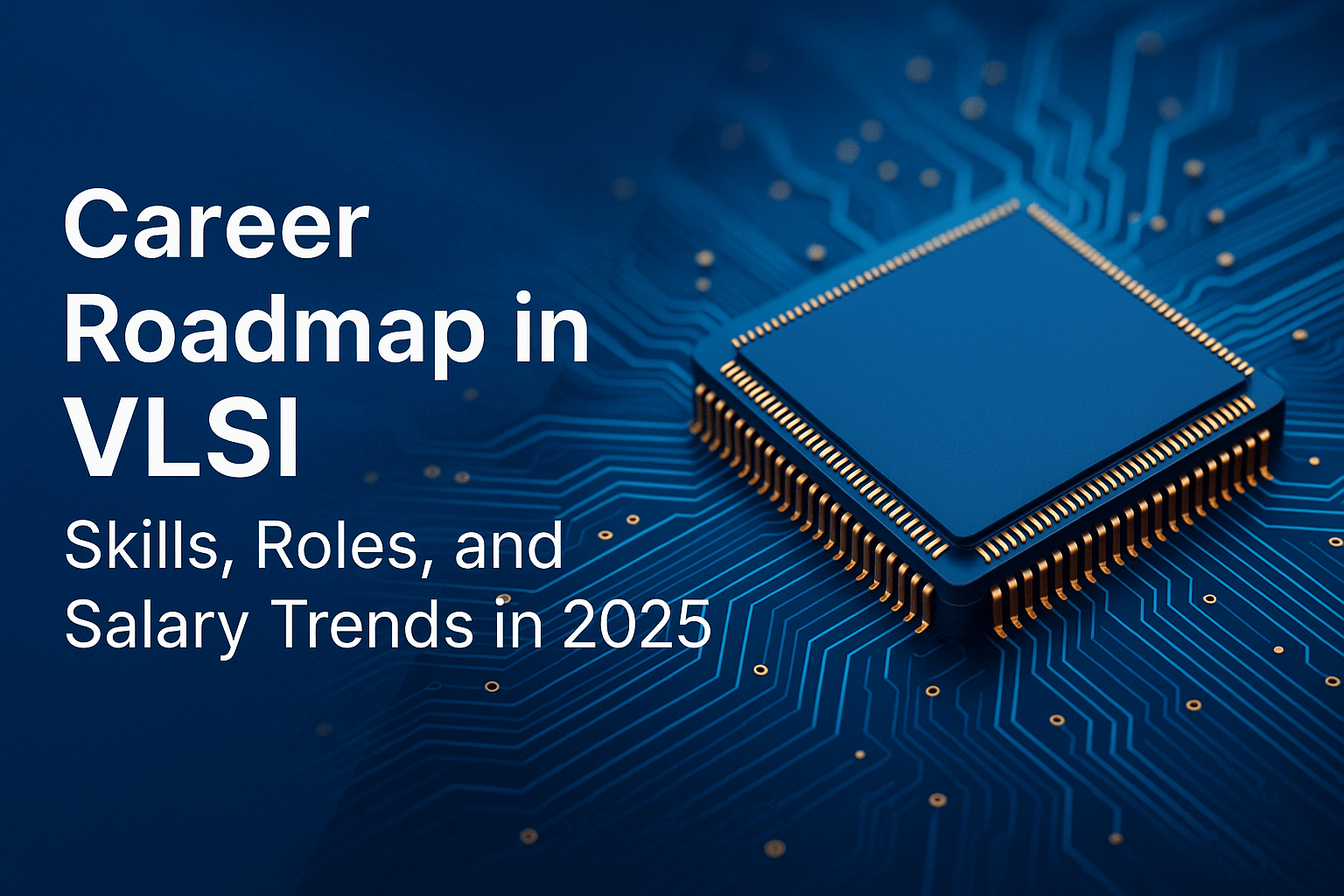Career Roadmap in VLSI: Skills, Roles, and Salary Trends in 2025
In 2025, the demand for skilled VLSI (Very-Large-Scale Integration) professionals continues to surge, driven by explosive growth in AI chips, 5G hardware, IoT devices, and automotive semiconductors. For electronics and electrical engineers, VLSI offers one of the most stable, lucrative, and intellectually rewarding career paths. But how do you navigate this complex and ever-evolving industry?
This blog offers a complete career roadmap in VLSI, covering essential skills, key job roles, and salary trends to help you get started—and thrive—in 2025 and beyond.
Why Choose a Career in VLSI?
VLSI professionals are the unsung heroes behind the chips powering smartphones, EVs, data centers, and AI accelerators. With semiconductors now at the heart of global innovation, VLSI engineers are more valued than ever.
Some reasons to consider a VLSI career:
- Evergreen industry with long-term growth.
- High-paying job roles even at the entry level.
- Global demand from top semiconductor companies.
- Opportunities to work on cutting-edge tech: AI, ML, 5G, AR/VR, and more.
Educational Path: What You Need to Get Started
To begin a career in VLSI, you typically need:
- Bachelor’s Degree (B.E./B.Tech) in ECE, EE, or Instrumentation.
- Master’s Degree (M.E./M.Tech) in Microelectronics or VLSI is a plus.
- VLSI Certification/Internship from industry-aligned institutes like ChipXpert VLSI Training Institute Hyderabad & Bengaluru.
Career Tracks in VLSI: Frontend vs Backend
VLSI careers split into two major domains:
1. Frontend Design
Focuses on what a chip does.
Key Skills:
- RTL Design using Verilog/SystemVerilog
- Functional verification (UVM, assertions)
- High-level synthesis (HLS)
- Scripting: Python, Tcl
Common Job Roles:
- RTL Design Engineer
- Verification Engineer
- DV Engineer (Design Verification)
- FPGA Design Engineer
2. Backend (Physical) Design
Focuses on how the chip is physically built.
Key Skills:
- Digital IC Design Flow
- Floorplanning, Placement, Routing
- Timing Analysis (STA)
- Tools: Cadence Innovus, Synopsys ICC2, Calibre
Common Job Roles:
- Physical Design Engineer
- STA Engineer
- DFT (Design-for-Test) Engineer
- Physical Verification Engineer
Emerging Job Roles in 2025
With AI and automotive electronics reshaping chip design, new roles are evolving:
- AI Hardware Design Engineer
- SoC Integration Engineer
- Chiplet/3D-IC Architect
- Low-Power Design Engineer
- Hardware Security Engineer
Tip: Specializing early in trending domains like AI accelerators or Automotive VLSI can fast-track your career.
Must-Have Skills for VLSI Engineers in 2025
Technical:
- Verilog/SystemVerilog
- Digital electronics fundamentals
- Timing analysis & constraints
- Scripting (Tcl, Perl, Python)
- Hands-on with EDA tools (Cadence, Synopsys, Mentor)
Soft Skills:
- Problem-solving & debugging
- Communication (especially for verification roles)
- Team collaboration across global teams
- Continuous learning mindset
Salary Trends in VLSI (India & Abroad)
| Experience Level | India (INR/Year) | USA (USD/Year) |
|---|---|---|
| Entry-Level (0–2 yrs) | ₹6–10 LPA | $80K–$110K |
| Mid-Level (3–5 yrs) | ₹12–20 LPA | $120K–$150K |
| Senior (6+ yrs) | ₹25–40 LPA+ | $150K–$200K+ |
Note: Salaries also depend on your skillset, tools mastery, project exposure, and the company tier (Intel, Qualcomm, AMD, etc.).
Top Companies Hiring for VLSI in 2025
India:
- Intel
- Qualcomm
- AMD
- Texas Instruments
- Synopsys
- Cadence
- Micron
- MediaTek
- ChipXpert (for hands-on training + internships)
Global:
- NVIDIA
- Apple
- Broadcom
- ARM
- Tesla
- TSMC
- GlobalFoundries
How to Build Your VLSI Career (Step-by-Step)
Step 1: Get Strong in Fundamentals
Learn digital design, CMOS theory, and computer architecture.
Step 2: Pick Your Domain
Decide if you’re more inclined toward frontend (RTL, verification) or backend (PD, STA, DFT).
Step 3: Hands-on Projects
Build small designs (UART, FIFO, CPU blocks) and simulate using ModelSim or Vivado.
Step 4: Join a VLSI Training Institute
Opt for tool-based, industry-focused programs. Look for internships and real chip-level projects.
Step 5: Build Resume & Portfolio
Highlight tools, projects, and flow experience (e.g., Netlist-to-GDSII flow).
Step 6: Apply to Core Roles
Target internships and fresher roles in VLSI companies, or explore opportunities via campus placements, LinkedIn, or job portals.
Final Thoughts
A career in VLSI is not just about earning a good salary—it’s about shaping the digital future. From powering smartphones to enabling autonomous cars, your contribution as a VLSI engineer will touch billions of lives.
If you’re an electronics enthusiast with a logical mindset, this is your time. Equip yourself with the right skills, follow a focused roadmap, and your journey into the semiconductor world will be full of opportunities.
Explore VLSI training programs at ChipXpert and take the first step toward your dream chip design career.
Want to dive deeper into the Physical Design flow? Check our detailed guide here: Complete Physical Design Flow in VLSI



